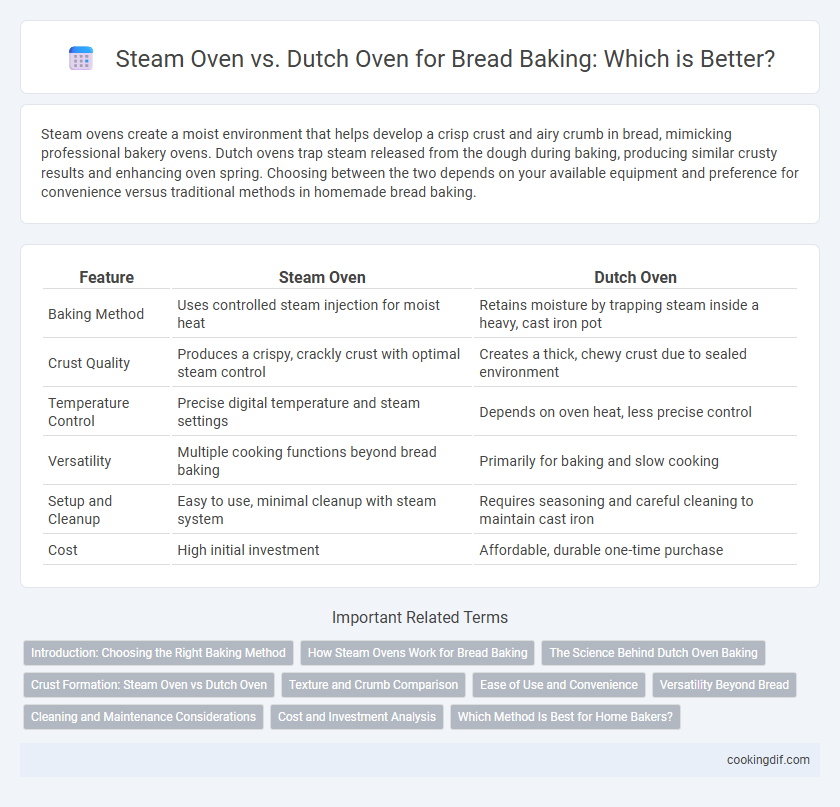Steam ovens create a moist environment that helps develop a crisp crust and airy crumb in bread, mimicking professional bakery ovens. Dutch ovens trap steam released from the dough during baking, producing similar crusty results and enhancing oven spring. Choosing between the two depends on your available equipment and preference for convenience versus traditional methods in homemade bread baking.
Table of Comparison
| Feature | Steam Oven | Dutch Oven |
|---|---|---|
| Baking Method | Uses controlled steam injection for moist heat | Retains moisture by trapping steam inside a heavy, cast iron pot |
| Crust Quality | Produces a crispy, crackly crust with optimal steam control | Creates a thick, chewy crust due to sealed environment |
| Temperature Control | Precise digital temperature and steam settings | Depends on oven heat, less precise control |
| Versatility | Multiple cooking functions beyond bread baking | Primarily for baking and slow cooking |
| Setup and Cleanup | Easy to use, minimal cleanup with steam system | Requires seasoning and careful cleaning to maintain cast iron |
| Cost | High initial investment | Affordable, durable one-time purchase |
Introduction: Choosing the Right Baking Method
Selecting the right baking method significantly influences bread texture and crust quality, with steam ovens offering precise humidity control for artisan-style loaves. Dutch ovens excel at retaining heat and moisture, creating a robust, crispy crust similar to commercial bakery results. Understanding the benefits of steam ovens versus Dutch ovens helps bakers achieve desired bread characteristics efficiently.
How Steam Ovens Work for Bread Baking
Steam ovens enhance bread baking by injecting controlled moisture and heat, creating an ideal environment for crust development and oven spring. The steam delays crust formation, allowing the dough to expand fully, resulting in a lighter, airier crumb. Precise temperature and humidity control in steam ovens produce consistent, professional-quality artisan bread with a crisp, glossy crust.
The Science Behind Dutch Oven Baking
Dutch oven baking leverages the heavy, cast-iron pot's ability to trap steam, creating a humid environment that enhances crust development and oven spring in bread. The enclosed heat retention promotes even baking temperatures, allowing the dough to rise fully before the crust hardens. This method mimics professional steam-injected ovens, producing a chewy, glossy crust with a tender crumb.
Crust Formation: Steam Oven vs Dutch Oven
Steam ovens create an ideal humid environment that promotes a crispy, glossy crust by allowing the dough surface to remain moist during the initial baking phase. Dutch ovens trap steam released from the dough itself, resulting in a crust with a rustic, thick texture and deep caramelization. While steam ovens offer precise humidity control for consistently thin and crackly crusts, Dutch ovens provide a more traditional crust with pronounced blistering and chewiness.
Texture and Crumb Comparison
Steam ovens create a moist baking environment that enhances crust crispness and promotes an open, airy crumb by allowing the dough to fully expand during oven spring. Dutch ovens trap steam released from the dough, resulting in a similarly crisp crust but often producing a denser crumb due to less consistent humidity levels. Both methods improve crust texture, yet steam ovens excel in controlling humidity to achieve lighter, more open crumb structures in artisan bread baking.
Ease of Use and Convenience
Steam ovens offer precise humidity control and automated settings, simplifying the bread baking process with consistent results and minimal supervision. Dutch ovens require manual preheating and careful handling but excel at retaining heat and moisture for artisan-style crusts. For ease of use and convenience, steam ovens are ideal for bakers seeking straightforward, hands-off operation, while Dutch ovens suit those comfortable with a more hands-on, traditional approach.
Versatility Beyond Bread
Steam ovens provide precise humidity control that enhances not only bread crust crispness but also the texture of steamed vegetables, fish, and desserts, making them ideal for diverse cooking techniques. Dutch ovens excel at retaining and evenly distributing heat, perfect for slow-cooking stews, roasting meats, and baking artisan bread with a rustic crust. Both appliances extend well beyond bread baking, offering versatility for roasting, braising, and steaming a wide range of dishes in home kitchens.
Cleaning and Maintenance Considerations
Steam ovens require minimal cleaning due to their self-cleaning steam functions and non-stick surfaces, while maintaining consistent moisture levels prevents residue buildup. Dutch ovens, often made of cast iron or ceramic, demand thorough hand washing and careful drying to avoid rust or cracks, and occasional seasoning to preserve the surface. Choosing between these options depends on balancing convenience in cleanliness with durability and traditional baking qualities.
Cost and Investment Analysis
A steam oven typically requires a higher initial investment, often ranging from $200 to $1,000, reflecting advanced technology and precise humidity control for artisan-quality bread. Dutch ovens, priced between $30 and $100, offer an affordable, durable alternative capable of retaining heat and creating steam by trapping moisture during baking. For home bakers prioritizing cost-effectiveness, a Dutch oven represents a lower upfront expense, while steam ovens offer long-term value through consistent results and programmable settings.
Which Method Is Best for Home Bakers?
Steam ovens provide precise humidity control that enhances crust development and oven spring, making them ideal for achieving bakery-quality bread at home. Dutch ovens trap steam effectively by creating a sealed environment, resulting in a crispy crust and moist crumb, and they remain a popular and affordable choice for home bakers. The best method depends on the baker's preference for convenience, control, and the type of bread being baked.
Steam Oven vs Dutch Oven for baking Infographic

 cookingdif.com
cookingdif.com